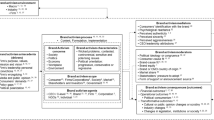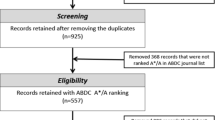Abstract
Cisco is undergoing a transformation in its business to put itself at the heart of the ‘Internet of Everything’. At the same time, it is seeking to ensure its customers enjoy a positive experience of the brand. Language was identified as an area where it needed to improve clarity and consistency, leading to a programme of training staff in how to talk the brand.
Similar content being viewed by others
Background
Cisco has enjoyed a strong brand from the outset of the business. Having a function devoted specifically to the brand experience is relatively new, however — the function was only set up in 2012. As with most brand owners, it had previously been considered as an adjunct to the brand marketing role.
According to Michael Lenz, appointed to the position of director of brand experience in late 2012, ‘a few years ago usability was a differentiator. Now it is the table stakes in a lot of businesses. Today there is a massive focus on customer experience’. Just as customer experience has been grouped together as a specific function with its own resources, Lenz believes brand experience is following the same trajectory.
Identifying the potential to bring together the complete brand experience was no easy task for a global brand with 527 offices and 74,000 employees globally. Cisco has made over 150 acquisitions and its structure shows that history, even though it is a single entity.
However, the brand already had some experience in delivering emotional experiences of the brand, such as through Cisco Live, which in 2013 attracted 20,000 registrants and 235,000 virtual visits. The challenge for the business was that different parts of the brand experience sat within a variety of functions — such as the global events team, which staged the conference; technical services, which owns the call centres; manufacturing, which controlled the ‘out of the box’ experience of implementing a Cisco product; and a separate team managing the website. ‘No single team was responsible for intentionally developing the over-arching experience’, recalls Lenz.
Problem
Cisco has been transforming itself from a networking company to be viewed by customers as the most strategic IT partner at the heart of the emerging ‘Internet of Everything’. For Lenz, this is as much of a challenge as when retailers were starting to think about e-commerce in the late 1990s. ‘At that time, people either got it or didn’t anticipate the scale of the change’, he says. Cisco itself was one of the first B2B brands to go fully digital, removing all of its offline processes. As a result, it became a leader in business transformation for internet businesses.
Cisco needed to understand what its brand experience currently was, as well as what it wanted it to be. Lenz notes that the business has a famed reputation for resolving client issues. Engineering a change in that culture is difficult, not least because people become used to the adrenalin charge of last minute resolution.
By contrast, Cisco has long been good at identifying trends and being prepared to meet emerging customer needs. Through its combination of technology and services, it is effectively a B2B2C brand. That demands a high level of empathy in order to understand both the needs of the direct client (the middle ‘B’) and of that client’s end customers (the final ‘C’).
At the same time, the rate of innovation in the technology solutions market has accelerated. ‘In the old days your solutions were like a casserole, all the ingredients baked together. If you wanted to change something you had to start over. Today you have access to all those ingredients as a service. This allows you to deploy new services almost immediately on an intelligent network’, says Lenz. As a key provider, Cisco is coming into contact with a new era of ‘co-opetition’ and clients that have a different culture and way of doing business to the ‘old boys’ club’ of the historical IT industry.
Language therefore becomes both an issue and an opportunity, since Cisco’s employees need to be able to communicate clearly and with empathy to this new class of client. ‘It is like open versus closed systems — like the four different video applications commonly used today. They could use the open standard to get them to work together but choose not to’, Lenz says.
‘We’re right there with the CIO. But as we want to be viewed by customers as the most strategic partner and pursue that path, we need to be able to communicate with the other side of the C-suite’, notes Lenz. ‘Language starts to come into that. It is the next opportunity for a competitive advantage’.
Cisco’s problem was that it was well-known for having a distinctive vocabulary to describe its products and services, one that was heavily reliant on jargon and three-letter acronyms. This had specific impacts and cost implications, such as new consultants requiring longer to get up to speed with that vocabulary when joining the business than new joiners at other companies. ‘The language was shorthand, but the learning process took quite a bit longer. Team members outside a given group wouldn’t understand the conversation and it slowed us all down’, says Lenz.
Solution
Lenz has worked at Cisco for ten years in system design, rather than coming from a marketing background. His human-centred design training means he has brought to brand experience a scientific, ‘test and learn’ approach. The starting point for understanding what brand experience customers had of Cisco was to consider what language was being used across the company. That led to a recognition of the need to change communications from the inside out, starting with employee communications.
‘I’m not sure who started it, but 15 years ago we adopted the third person AP (Associated Press) style of writing for our internal communications — “Cisco did this ...”, “Cisco does that ...”. When an employee reads that, they wonder why it doesn’t say “we” or “us”. It is not building empathy’, says Lenz. He sees that example as a microcosm of the bigger issue.
An employee communications team of ten people was having a major influence over the language deployed by Cisco employees. ‘In our research into our brand experience, we identified language as a key component where we were not meeting customer expectations’, Lenz says.
The brand experience team began by looking at the master brand in terms of its written and verbal identity, as well as how it is experienced through other senses. This revealed a strongly positive view of Cisco as a tactile and visual brand — the way its products look and feel is always commented on by customers and has a consistency.
‘The problem was we didn’t have the same recognition in the written word, so we had to change it’, says Lenz. ‘We need to provide a distinctive experience through our use of language. But changing it was really undertaking a cultural change’. He drew up a request for proposals and chose language consultancy The Writer from a shortlist for its global experience with consulting and technology companies.
The focus of the project was to help Cisco deliver on its brand promise when interacting with customers and partners. With stable, core brand values that have remained unchanged for 28 years, the objective was how to deliver those values in every interaction. ‘What we were trying to do was ensure we had a written and verbal language that extended our mature design principles into other realms of experience’, says Lenz.
Once that language definition had been created, a programme was developed to introduce it across the enterprise. The new approach was about ‘allowing people to talk like they do normally, not to speak like a technologist just because they work in a tech company’, Lenz says.
The Writer had to adopt a different approach from its previous client engagements, however, since face-to-face training was not cost effective. Instead, training was broken down into modules that could be delivered via TelePresence, Cisco’s industry-leading video conferencing tool. This put the trainers into a virtual room with groups of students across multiple locations at the same time.
The Writer had to adjust its training techniques to suit, since the concentration and energy levels of learning via video are different from physical presence, regardless of the HD, lag-free quality of the virtual experience. ‘You can’t do this kind of training using traditional video conferencing. With TelePresence and Jabber Video, the trainers could see the slightest expressions on their students’ faces. This allowed them to ask clarifying questions and pull anyone struggling back into the fold’, says Lenz.
Cisco also had to prioritize where to start training given its scale. Outbound communicators were the initial focus: public and investor relations, sales enablement and internal marketing were identified as the first functions to be trained before rolling the programme out.
In the first element of training, students are taken through the cultural transformation. This is followed by practical exercises to help them feel the difference between the previous language and the new brand experience. As part of what helped to convince the business about the value of the shift, Lenz points to studies carried out at Princeton that examined the effect on perceptions of a source between simple, clear language and complex versions.
These demonstrated that when content is expressed in a straightforward way, the source is considered to have a level of mastery and a higher degree of intelligence. ‘Simplicity does not equal stupidity’, says Lenz. The ‘playbook’ that explains the new culture and language is a perfect example in its own right — it is just eight pages long.
Benefits
The benefits of the transformation in Cisco’s use of language will be recognized in the brand experience of its customers. A range of metrics are used to measure this, alongside customer experience, and Lenz expects to see steady improvements in both as a result of his team’s efforts.
‘A simple measure for us is the relevancy of our messaging. We have already seen a marked increase in the relevancy of our messaging just by changing the language’, he says. ‘If you think about an offer letter, you can ask three questions and get a sense if it is delivering a good experience. Does it have a positive attitude? Is it personalized and relevant? Does it meet that person’s expectations? Those simple questions will tell you if you are helping or hurting your brand’.
Journey mapping has shown that measuring the full brand experience is more complex, since it ranges from first awareness of the brand through potentially years of the customer’s relationship up to the present day. But Lenz says the experience of conversations with senior clients is that they are already being conducted in a completely different way to previous interactions.
‘It is about letting our people be who they are. For a client director managing a $1 billion account, it is about letting them do what they do best — deliver an incredible customer experience. Our new brand language allows them to do that’, says Lenz.
Rights and permissions
About this article
Cite this article
Reed, D. Adopting a new brand language at Cisco. J Direct Data Digit Mark Pract 15, 47–50 (2013). https://doi.org/10.1057/dddmp.2013.37
Received:
Published:
Issue Date:
DOI: https://doi.org/10.1057/dddmp.2013.37




